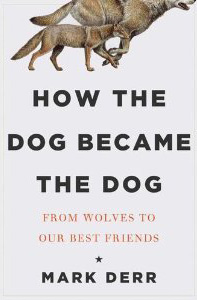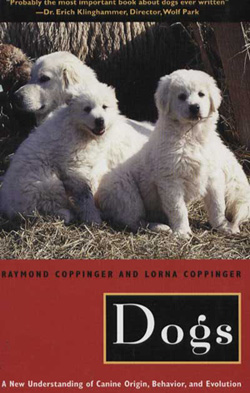How the Dog Became the Dog – Mark Derr
January 12, 2012
 For those of you who follow the ongoing debate about the evolutionary origin of dogs Mark Derr‘s new book, How the Dog Became the Dog: From Wolves to Our Best Friends is essential reading. The take-away is that the latest evidence casts doubt on the previously accepted dates for the emergence of the dog from the wolf. Derr makes the case that there was co-evolution of primitive man and wolf into modern man and domesticated dog. This is the track that Temple Grandin also posits in her recent book, Animals Make Us Human: Creating the Best Life for Animals.
For those of you who follow the ongoing debate about the evolutionary origin of dogs Mark Derr‘s new book, How the Dog Became the Dog: From Wolves to Our Best Friends is essential reading. The take-away is that the latest evidence casts doubt on the previously accepted dates for the emergence of the dog from the wolf. Derr makes the case that there was co-evolution of primitive man and wolf into modern man and domesticated dog. This is the track that Temple Grandin also posits in her recent book, Animals Make Us Human: Creating the Best Life for Animals.
The reasons for this are complex and Derr has a great ability to probe the archeological record and question the assumptions of previous researchers. Every modern book on dog evolution cites the work of Dmitry Belyaev with the Russian Silver Fox. In breeding for “tameness” over many generations for 40 years Belyaev reported physical changes in his foxes: body shapes altered in size and proportion, coats became piebald, tails became curled, ears floppy and increased cyclical rates of reproduction. Wild female foxes mate once a year, their cycle is cued by changes in daylight. Dogs can mate and bear young in any season, and more than once each year.
These results are said to make the case for primitive man selecting the tamest of wolves that followed their campsites and slowly transformed them into the domestic dog. Derr explains some of the problems with making this connection and challenges its explanatory power. In this he is making a counter-argument to the ground breaking work of Raymond and Lorna Coppinger in their book, Dogs: A New Understanding of Canine Origin, Behavior and Evolution. I think Coppinger makes an excellent case for his view and also consider his book essential reading, without knowing truly who is right in this debate.

Both would agree, I think, that domestication of the wolf into the modern dog was not an event which occurred only once or in a single location. The facts suggest a more complex and less straightforward process. It may even be the case that we will never know precisely how this all played out after the last of the Ice Ages. But Derr makes a major contribution to the conversation with his new book.
Comments
Got something to say?
You must be logged in to post a comment.
